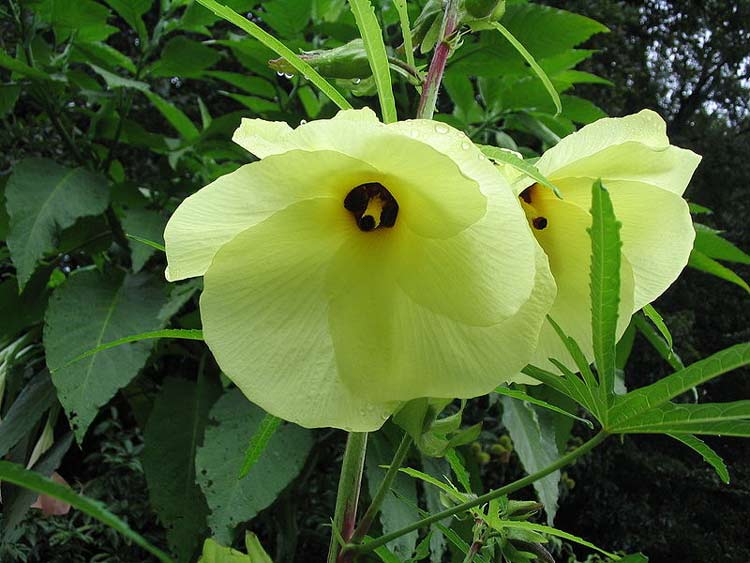
Abelmoschus manihot (*)
Classification System: APG IV
Superregnum: Eukaryota
Regnum: Plantae
Cladus: Angiosperms
Cladus: Eudicots
Cladus: Core eudicots
Cladus: Rosids
Cladus: Eurosids II
Ordo: Malvales
Familia: Malvaceae
Subfamilia: Malvoideae
Tribus: Hibisceae
Genus: Abelmoschus
Species: Abelmoschus manihot
Subspecies: A. m. subsp. manihot – A. m. subsp. tetraphyllus
Name
Abelmoschus manihot (L.) Medik. (1787)
Synonyms
Basionym
Hibiscus manihot L., Sp. Pl. 2: 696. 1753.
Homotypic
Bamia manihot (L.) Wall., Numer. List n. 1926. 1829, comb. inval.
References
Medikus, F.K. 1787. Ueber Einige Künstliche Geschlecter aus der Malven-Familie, , denn der Klasse der Monadelphien 46.
USDA, ARS, Germplasm Resources Information Network. Abelmoschus manihot in the Germplasm Resources Information Network (GRIN), U.S. Department of Agriculture Agricultural Research Service. Accessed: 07-Oct-06.
Vernacular names
한국어: 닥풀
Abelmoschus manihot, the aibika, is a flowering plant in the family Malvaceae. It was formerly considered a species of Hibiscus, but is now classified in the genus Abelmoschus. The plant is also known as the sunset muskmallow, sunset hibiscus, or hibiscus manihot.
Applications
See also: Mucilage
In the Philippines it is known variously as lagikway, likway, gikway, barakue, or nating saluyot. Its leaves and shoots are eaten as a vegetable, similar to the related saluyot (Corchorus olitorius). The leaves are added to dishes like tinola, sinigang, and pinangat, or eaten in salads.[2]
In Japanese, this plant is known as tororo aoi and is used to make neri, a starchy substance used in making the traditional Japanese paper washi. In Korean, this plant is known as hwang chok kyu and is used to make dak pul, which assists in making hanji (Korean paper).
Chemical constituents
A chromatographic and spectroscopic analysis published in China Journal of Chinese Materia Medica showed that aibika contained thirteen compounds: myricetin, cannabiscitrin, myricetin-3-O-beta-D-glucopyranoside, glycerolmonopalmitate, 2, 4-dihydroxy benzoic acid, guanosine, adenosine, maleic acid, heptatriacontanoic acid, 1-triacontanol, tetracosane, β-Sitosterol, and beta-sitosterol-3-O-beta-D-glucoside.[3]
Nutrition
Although technically a shrub, aibika is a perennial which, under good conditions, can grow to over three meters in height. It is reputedly an extremely nutritious vegetable. Its leaves are very high in vitamins A and C, and iron, and have 12% protein by dry weight. Moreover, it is easily propagated from cuttings, easy to cultivate, relatively disease-resistant and even is considered to be of medicinal value. It is widely planted either along borders of gardens or as an intercrop throughout many traditional gardens in the tropics.[4]
References
"Abelmoschus manihot (L.) Medik". Plants of the World Online. Board of Trustees of the Royal Botanic Gardens, Kew. 2017. Retrieved 13 August 2020.
Maghirang, Rodel G. (14 January 2017). "Lagikway, The Perennial Shrub". Agriculture Monthly.
Lai, X. Y.; Zhao, Y. Y.; Liang, H. (2006). "Studies on chemical constituents in flower of Abelmoschus manihot". China Journal of Chinese Materia Medica. 31 (19): 1597–1600. PMID 17165583.
Thaman, R.R. Rural Fiji. Institute of Pacific Studies, University of the South Pacific 1988, p. 41.
Retrieved from "http://en.wikipedia.org/"
All text is available under the terms of the GNU Free Documentation License

